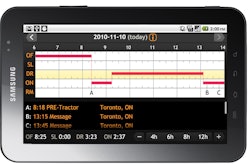Baltimore Gas and Electric announced that it has chosen Networkfleet’s telematics solution integrated with AssetWorks FleetFocus asset management software to track GPS location and report on maintenance issues for 400 utility service vehicles. BGE intends to use the joint technology solution to streamline maintenance scheduling and reduce vehicle downtime.
BGE serves more than 1.2 million electric customers and more than 640,000 gas customers in the Baltimore-Metro area, including all or part of 10 Central Maryland counties. BGE will install Networkfleet with AssetWorks FleetFocus integration primarily on heavy-duty vehicles.
BGE says the integration of Networkfleet’s telematics technology with FleetFocus provides quick and easy access to vehicle location, engine diagnostics and vehicle maintenance alerts without having to switch to another application. Additionally, real-time odometer readings are sent directly from the vehicle to FleetFocus, which Networkfleet says saves time, increases accuracy and allows for timely scheduling of preventive maintenance.
“After carefully considering multiple vendors, BGE chose Networkfleet and FleetFocus primarily because of their close integration,” says Burton Jackson, BGE director of fleet services. “If Networkfleet’s system detects a vehicle engine problem, a service request is automatically generated in FleetFocus. The interaction between the two systems will make our fleet management process more efficient and more cost-effective. Identifying potential component failures in advance helps us reduce the cost of repairs and increase the life of the vehicle.”
“For utility fleets, it is especially important to stay on top of maintenance issues because vehicles are in constant use,” says Keith Schneider, president and chief executive officer of Networkfleet. “The combination of Networkfleet and AssetWorks helps fleets to be proactive regarding maintenance. For example, they no longer have to rely on the driver to report engine problems or odometer readings to schedule maintenance. At the same time, utility fleets can use Networkfleet to monitor fuel usage and idle time, allowing them to reduce fuel consumption and lower emissions.”











